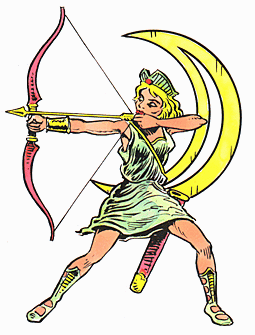Diana or Luna
Diana, or Luna, Roman goddess of the Moon, animals,
and hunting (earth’s moon).

Luna gives us “lunar” from Latin lucere, to shine.
Symbol: a crescent Moon.

- Called Luna by the Romans, Selene and Artemis by the Greeks, and many other names in other mythologies.
- The twin sister of Apollo was Artemis; also known as Diana, Phoebe, Selene, or Cynthia; goddess of the Moon, of maidens, of hunting (the chase), and daughter of Zeus and Latona.
- In works of art, this goddess is generally represented as a beautiful maiden, clad in a short hunting dress, armed with a bow, a quiver full of arrows at her side, and a crescent on her well-poised head.
- The sudden deaths of women were attributed to her shafts; but, she was, also, a goddess of healing.
- She was often represented as a huntress, with hunting dogs and a boar’s head at her side.
- Diana is described as guiding her silvery chariot over the sky at night.
- She had three aspects: Diana in the heavens, Luna on earth, and Hecate, goddess of witchcraft, in the underworld.
A few scientific facts about the Moon and the Earth
- Moon and Earth, tied together by gravitational attraction, revolve as a double planet.
- Total eclipses occur when the Moon and Earth line up perfectly with the Sun.
- During a solar eclipse, the Moon passes between the Sun and Earth, hiding the Sun on a small area of Earth.
- During a lunar eclipse, the full Moon moves into Earth’s shadow and is blacked out.
- Because Earth spins faster than the Moon revolves, the Moon rises an average of 50 minutes later each night.
- During the new phase, Moon and Sun rise and set at the same time; but, from then on, the Moon appears in different parts of the sky: in the west as it waxes larger towards gibbous, in the east as it wanes smaller.
- The gravitational force of the Moon, and to a lesser extent the Sun, raises the ocean tides on Earth.
- A great bulge of water is pulled up on the side of the Earth facing the Moon and held there.
- As Earth rotates beneath the bulge, high tides occur and then because of Earth’s rotation, the tide seems to move from east to west.
- None of the other planets has a moon like the Earth. Mercury and Venus have no moons at all, and Mars is orbited only by two tiny chunks of rock, each just one ten-millionth the size of Earth’s moon.
- Because the Moon rotates on its axis in exactly the time it takes to orbit the Earth, it always presents the same side to us.
- The Moon does not emit light. What we see is sunlight reflected from the Moon’s surface as the Moon goes through its familiar phases.
 You may return to the page of planet images from here.
|

